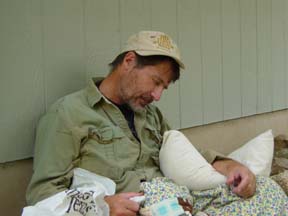To study these maps in detail, go to Journey North's website for
Fall 2009 (or previous years), scroll down and click on the map for "Roosts" or "Peak sightings". Be sure to click on the "Animated Map" link at the bottom of each map there to really get a feel for the flow of the migration. Watch the pattern in 2009 as concentrations were detected unusually far to the west in Kansas, Oklahoma, and the Texas Panhandle, with the highest densities perhaps moving through San Angelo, Sonora, and even in far West Texas at Balmorhea--deftly skirting the Texas Hill Country this year. The vagaries of weather patterns always leave me scratching my head when the Monarchs or the major hawk movements bypass us at this Refuge. We can't take it personally--all these critters are just masters at "going with the flow", quite literally. Some years we are the beneficiaries of these patterns (as we were with Swainson's Hawks in early October) and sometimes not; that's the fun and frustration of migration watching.
The topic of how Monarchs accomplish the navigational feat of moving from the eastern and central U.S. to arrive at a small set of over-wintering targets in Mexico is worthy of greater essays than I have space for here. This aspect has garnered much attention from inventive field and laboratory researchers. I include a few of the more notable and recent titles in my reference list below. But consider some of the major questions: Even with some pretty good genetically-inherited skills, how would
you figure out how to navigate to one tiny area in central Mexico that you've never visited before? Landscape clues? Magnetic compass? Body clocks? Wind/weather clues and cues? The sun/moon/stars? Head out to your garage and invent for yourself a "time-compensated sun compass" and you'll get a sense of what researchers have focused on in recent years. The newest news on this topic involves the finding that the GPS system for Monarchs is apparently
located in the antennae of the butterflies!
At the Refuge, we have tagged about 50 Monarchs thus far this season on their southbound pathway. The number we tag gyrates wildly from year to year (high: 234 tagged in 2001) based primarily on the aforesaid migration vagaries, but also on the available volunteer and staff time devoted to the task, and the grace and forehand skills of our would-be Monarch netters. I believe Outdoor Recreation Specialist Rob Iski and new SCA volunteer Elizabeth Lesley are about tied for the lead in this season's tagging rodeo.
Refs and Further ReadingWebsites:Journey North, Monarch migration maps of Fall migration at:
http://www.learner.org/jnorth/monarch/ Click on the "Here's the latest news" link in the center of the page for great animated maps.
Library of Congress, Scientific Reference Services. Science Reference Guides: The Migration of the Monarch Butterfly, online at:
http://www.loc.gov/rr/scitech/SciRefGuides/butterfly.html This site has a good introductory bibliography of Monarch research.
Monarch Watch, Home page at:
http://monarchwatch.org/University of Arizona, Honors Biology class page on Monarch migration:
http://student.biology.arizona.edu/honors2002/group10/Monarchmigration.htmResearch Articles:Lincoln P. Brower. 1995. Understanding and misunderstanding the migration of the monarch butterfly (Nymphalidae) in North America. J. Lepid. Soc. 49(4):304-385.
Lincoln P. Brower. 1996. Monarch butterfly orientation: missing pieces of a magnificent puzzle. J. Exper. Biol. 199:93-103.
William H. Calvert. 2001. Monarch butterfly (
Danaus plexippus L., Nymphalidae) Fall migration flight behavior and direction in relation to celestial and physiographic cues. J. Lepid. Soc. 55(4):162-168.
Jason A. Etheredge, Sandra M. Perez, Orley R. Taylor, and Rudolf Jander. 1999. Monarch butterflies (
Danaus plexippus L.) use a magnetic compass for navigation. Proc. Nat. Acad. Sci. 96(24):13845-13846.
Oren Froy, Anthony L. Gotter, Amy L. Casselman, and Steven M. Reppert. 2003. Illuminating the circadian clock in Monarch butterfly migration. Science 300:1303-1305. Abstract at:
http://www.sciencemag.org/cgi/content/abstract/300/5623/1303Christine Merlin, Robert J. Gregear, and Steven M. Reppert. September 25, 2009. Antennal circadian clocks coordinate sun compass orientation in migratory Monarch butterflies. Science 325:1700-1704.
Steven Reppert, H. Zhu, and R. White. 2009. Polarized light helps Monarch butterflies navigate. Current Biology 14(2):155-158.
* * * * *
"Below The Line":
In one migration narrative many years ago for the seasonal Texas column in American Birds, I elicited groans from my editors and readers when I penned the phrase, "Willets wandered widely..." Hey, I call 'em like I see 'em!"A mind is a terrible thing to waste, but sometimes it's a scary thing to use."
CWS
 (Photo credit: Annie Sexton.
(Photo credit: Annie Sexton.
Wardrobe consultant: Mary Kay Sexton.
Luggage provided by Texas Dept. of Transportation.)